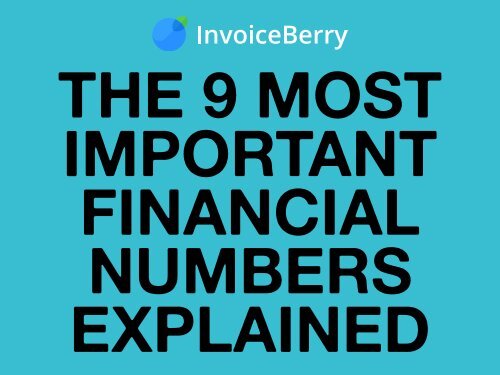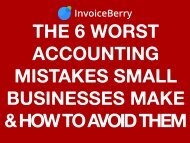The 9 Most Important Financial Numbers Explained
Check out our summary of the 9 most important financial numbers you need to know, and why your small business should watch them regularly
Check out our summary of the 9 most important financial numbers you need to know, and why your small business should watch them regularly
You also want an ePaper? Increase the reach of your titles
YUMPU automatically turns print PDFs into web optimized ePapers that Google loves.
THE 9 MOST<br />
IMPORTANT<br />
FINANCIAL<br />
NUMBERS<br />
EXPLAINED
Introduction<br />
Small business owners are known to carry a lot of weight<br />
on their shoulders. This goes without saying.<br />
However, because they take so much upon themselves,<br />
they lack the time to really learn about the most important<br />
parts of their business. This includes finances.<br />
Finances cannot be overlooked for any business, especially<br />
the small ones or freelancers. That’s why today we’ll look at<br />
the most important financial numbers every business needs<br />
to know.
1. Cash Flow<br />
Operating cash flow is the most important part of your business<br />
and should have all your focus. To calculate this important<br />
number:<br />
Cash inflow – cash outflow = cash flow<br />
If it’s positive, and you have more inflow (money from goods<br />
and services) than outflow (bills, loan payments, taxes, etc.),<br />
your business is doing fine.
2. Net Income<br />
Also known as net profit or net earnings, your net income is very<br />
much related to your cash flow. This is a good indicator of how<br />
your business is doing, as it will help determine if you need to<br />
adjust your business, or if you are on the right path.<br />
Your income – expenses (including taxes) = net income<br />
Knowing this number will help you determine the financial<br />
position of your business.
3. Profit and Loss<br />
Your Profit & Loss (P&L or income) statement is crucial, as it<br />
gives you a snapshot of the financial status of your business. In<br />
order to calculate Profit & Loss:<br />
company revenue – company expenses = profit or loss<br />
If this numbers comes out to be positive, that means your<br />
business has made a profit. If negative, however, your business<br />
has made a loss.
4. Cost of Revenue<br />
<strong>The</strong> Cost of Revenue helps you to determine what you should<br />
charge on an hourly rate based on what it actually costs you to<br />
produce a product or service. To calculate it:<br />
Raw Materials + Direct Labor + Shipping/Transportation<br />
Costs + Sales Commission = Cost of Revenue<br />
In order to make a profit, your charges should be higher than<br />
your cost of revenue. If it is equal or less than CoR, you should<br />
be charging more.
5. Gross Margin<br />
Also known as the gross profit, this is related to your cost<br />
of revenue. It measures how much money is left over after<br />
you’ve subtracted the cost of your merchandise or services. To<br />
calculate it:<br />
Sales price – Cost to produce good/service = Gross Margin<br />
If you are in a competitive market, your margin will be quite low,<br />
but if you have a propreity goods or high quality services, your<br />
margin can be high.
6. Total Inventory<br />
For many small businesses that sesll physical goods, it’s<br />
important to measure inventory on a weekly basis to make sure<br />
that it isn’t increasing. If your inventory is increasing, this is<br />
usually an indicator of sales problems.<br />
Measure inventory on a weekly basis<br />
Your storage costs, waste, and of course reduced profits are<br />
connected to inventory, so it’s very important that you monitor<br />
your inventory number.
7. Days Sales Outstanding<br />
This is the average number of days it takes for your clients to<br />
pay your invoices. A small number is good, as it usually means<br />
more cash flow. A larger number means you need to chase your<br />
late payers. To calculate it:<br />
payment terms * 133% > Days sales outstanding<br />
If your DSO is high, you should follow one of our many tips on<br />
how to decrease payment time on invoices.
8. <strong>The</strong> Quick Ratio<br />
This number can quickly show the financial stability of your<br />
business. You get it from your balance sheet. For the quick<br />
ratio:<br />
current assets / current liabilities = quick ratio<br />
Your ratio should be greater than 1. If your ratio is unfortunately<br />
lower, that means that you’ll need to work to improve your<br />
company’s profitability.
9. Your 20% customers<br />
This is a number that has to do with the math related<br />
specifically to your customers. Basically, sort your customers<br />
by revenue, then take the top 20%. Those are your most<br />
valuable customers.<br />
<strong>The</strong> 20% highest revenue customers<br />
Know your top 20% cater to them, and work on converting the<br />
other 80% into top customers as well.
Read our full article by following the link below:<br />
<strong>The</strong> 9 <strong>Most</strong> <strong>Important</strong><br />
<strong>Financial</strong> <strong>Numbers</strong><br />
<strong>Explained</strong>
LEARN MORE ABOUT INVOICEBERRY’S<br />
ONLINE INVOICING SOFTWARE<br />
InvoiceBerry simplifies invoicing and expense tracking, helping you save your<br />
time and money. You can create your first invoice in under 60 seconds.<br />
Send<br />
Track<br />
Create<br />
Manage<br />
Track<br />
Multi-<br />
invoices<br />
expenses<br />
reports<br />
clients<br />
payments<br />
currency<br />
LEARN MORE<br />
SIGN UP
















